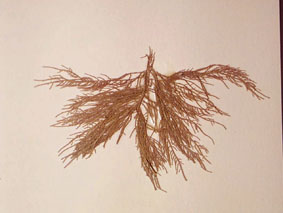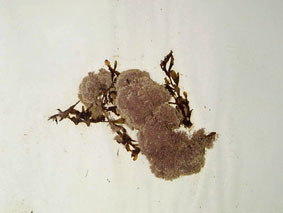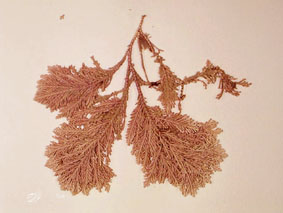
Division
The Rhodophytes, though referred to as the red algae, can be found in just about any color. They can tolerate a wider range of light levels than any other group of photosynthetic plants and occur in warm and cold waters. Red algae are therefore well represented in a variety of marine (and few freshwater) habitats. However, most red algae on rocky shores are limited to the lower shore turf by their vulnerability to desiccation.
Red algae are separated from other groups of organisms by virtue of the facts that they 1) are eucaryotic; 2) lack flagella in all stages; 3) store food reserves in cytoplasm as floridean starch (rhodophytes are thus often referred to as florideophytes); 4) produce chlorophyll a, carotenoids, phycobilins, and allophycocyanins as principal photosynthetic pigments; and 5) exhibit chloroplasts which lack external endoplasmic reticulum and contain unstacked thylakoids. Rhodophytes are also distinguished by their unique three-phased life cycle. Many red algae deposit calcium carbonate into their cell walls, making them hard (and excellent fossils).
Class, Subclass, and Order
All red algae belong to the class Rhodophyceae. Traditionally, this class has been divided into two subclasses, the Florideae and the Bangiodeae. The Florideae are divided into fifteen orders. The corallines in particular are now placed into the order Corallinales, though previously placed in the order Cryptonemiales which since has been absorbed by Gigartinales. Algae belonging to the order Corallinales are charaterized by lime deposition, making them harder than any other calcifying plant. The thalli of coralline algae consist of inarticulate (inflexible; not jointed) crusts or nodules or of articulated branches. Their reproductive cells are housed within tiny round chambers called conceptacles which, when mature or spent can be seen with the naked eye. Internally, coralline algal cells connect laterally via primary pit-connections and either direct secondary pit-connections or fusions (unisons of cells to form canals).
Family
Only one extant family, the Corallinaceae, is assigned to the Corallinales, though the extinct family Solenoporaceae is considered a sister taxon. The corallinaceans are divided into seven subfamilies which contain more than 40 genera. Four of these subfamilies contain nonarticulated genera. Amphiroideae and Corallinoideae are two of the three remaining subfamilies which contain the articulated corallines. Articulated coralline fronds consist of small calcified units, called intergenicula, and uncalcified units called genicula, which lie between each intergeniculum. The geniculated coralline algae, then, enjoy the advantage of flexibility. Thallus branching may be pinnate--one axial intergeniculum produces another axial intergeniculum between two lateral (branch) intergenicula, dichotomous--repeated forkings produce nearly equal branches, or both pinnate and dichotomous.
Subfamily to Genus
The subfamily Amphiroidea is distinguished by genicula with one or, more often, several tiers of cells, conceptacles located on lateral surfaces of the intergenicula, and by secondary pit-connections.
Both genera of the Amphiroidea appear along the Southern California coast. The genus Amphiroa is characterized by dichotomous branching and cylindrical or flat intergenicula that are ten times as long as they are broad. Lithothrix, which is represented by only one species, has cylindrical or semi-cylindrical intergenicula that are less than three times as long as they are broad and dichotomous irregularly distributed branches.
The subfamily Corallinoideae is represented by 12 genera, five of which are found in southern California. Traits of the Corallinoideae include genicula composed of a single tier of long cells, conceptacles located axially or marginally and/or laterally on intergenicular surfaces, and cells that are joined by fusions.
Members of the genus Jania are characterized by strict dichotomous branching, with axial conceptacles at branch tips, cylindrical or semi-cylindrical intergenicula, and sometimes rhizomatous rather than crustose bases.
Haliptylon is a genus that has both pinnate and dichotomous branching, axial conceptacles at the tips of the branched intergenicula, cylindrical or semi-cylindrical intergenicula, and sometimes rhizomatous rather than crustose bases.
The Corallina species are pinnately branched with axial conceptacles that appear on the tips of the unbranched intergenicula. They have flattened intergenicula which at times may be winged.
Members of the genus Bossiella exhibit pinnate and/or dichotomous branching. The conceptacles in this genus are lateral, appearing on the flattened, winged intergenicula.
Calliarthron is also pinnately and/or dichotomously branched. Conceptacles appear both marginally and laterally. Species have irregularly winged intergenicula that may be flat, cylindrical, or semi-cylindrical.
Species
Descriptions of the species of Amphiroa and Haliptylon which appear in Southern California are not included in this text.
Lithothrix aspergillum Gray. Formerly known as Amphiroa aspergillum . The thalli of this species are lavender-pink to dull purple in color. The fronds are clustered and range from 3 - 13 cm high. This species inhabits the low intertidal and shallow subtidal on the external surfaces of animals and rocks.

Jania tenella (Kutz.) Grun. Formerly known as Corallina tenella. This species is often mistaken for Jania adhaerens because in both, fronds form brownish pink, soft dense clumps 1-2 cm high. Jania adhaerens has rhizomatous bases and a branching angle greater than 45û while, Jania tenella has a crustose base with branching angles less than 45û. It is found in the mid-low intertidal on rocks or on other algae and often forms turf mats.

Jania crassa Lamour. Formerly known as J. micrarthrodia , J. natalensis and Corallina natalensis. This species is distinct from the others in the genus due to its larger size when mature. The fronds form clumps that can reach 7 cm tall and are a bright pinkish-lavender color with white tips. The species can be seen in the mid-low intertidal on rocks.

Corallina chilensis (Dec.) Kutz. Formerly known as C. officinalis. Fronds appear whitish pink, to pale lavender purple in this species. Lateral branches get progressively shorter near the apex and lie in one plane. These features distinguish C. chilensis from similar looking species found in the genus. It is seen in the low intertidal and subtidal areas on rocks, other plants, and on the external surfaces of animals.

Corallina vancouveriensis Yendo. Formerly known as C. aculeata, C. gracilis, C. densa, and C. lycopodiodes. At maturity, fronds may reach greater than 14 cm in height and are a dark violet color. In this species, lateral branches are appressed to the main axis in all planes giving the impression of a "squirrel's" tail or rosette. As the only California coralline able to withstand several hours of exposure, it is uncommon or absent below the rocky intertidal zone.

Bossiella orbigniana (Dec.) Silva. Formerly known as Amphiroa orbigniana. This species have bright pinkish mauve thalli that are commonly less than 10 cm tall. Primarily dichotomous branching separates this species from others in the genus. This species is sometimes found in kelp beds and throughout the subtidal and low intertidal on rocks.

Calliarthron cheilosporioides Manza. The dark pink to purple fronds of this species can reach 30 cm tall and have long (up to 7 mm) intergenicula. This species is commonly seen in kelp beds, low intertidal, and upper subtidal in surfy area on rocks.

1a. Intergenicula not winged . . . . . . . . . . . . . . 2
1b. Intergenicula winged . . . . . . . . . . . . . . . . 6
2a. Branching pinnate; intergenicula of lateral branches flat but intergenicula of central axis cylindrical . 3
2b. Branching dichotomous; intergenicula cylindrical or semi-cylindrical . . . . . . . . . . . . . . . . . . 4
3a. Lateral branches align with main axis in one plane; less likely to form turf mats . . . . . . . Corallina chilensis
3b. Lateral branches surround main axis tightly in all planes and become progressively shorter as they near apex; common turf former . . . . . . . . . . Corallina vancouveriensis
4a. Intergenicula roughly as long as they are broad . . . . . . . . . . . . . . . . . . . Lithothrix aspergillum
4b. Intergenicula longer than they are broad . . . . . . 5
5a. 1-2 cm high at maturity; commonly epiphytic . . Jania tenella
5b. More than 3 cm and up to 7 cm high at maturity; intergenicula longer and broader than those of other Jania species (lending ultimately to longer fronds); non-epiphytic . . . . . . . . . . . . . . Jania crassa
6a. Conceptacles borne only on faces of intergenicula, which are flat; usually two conceptacles per conceptacle-bearing intergeniculum; branching primarily dichotomous . . . . . . Bossiella orbigniana
6b. Conceptacles borne both on faces and on lateral wings of intergenicula, which are flat, irregularly shaped, and sometimes long; usually many conceptacles per conceptacle-bearing intergeniculum; branching primarily pinnate . . . Calliarthron cheilosporioides